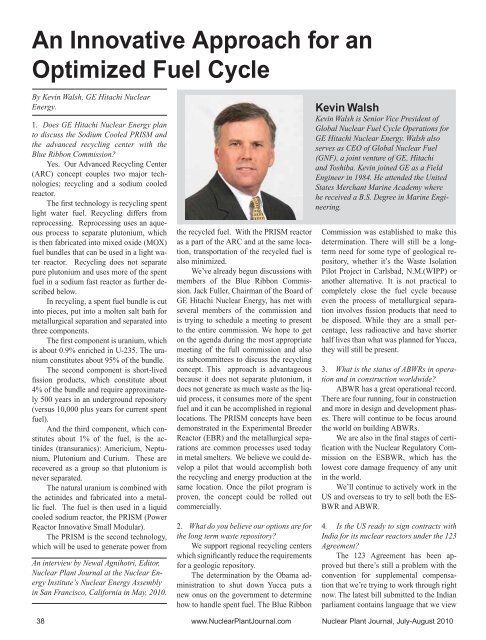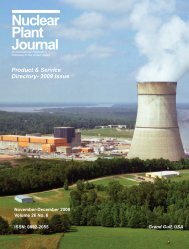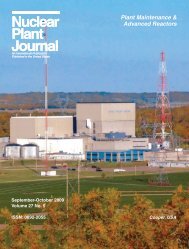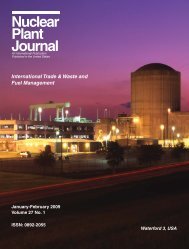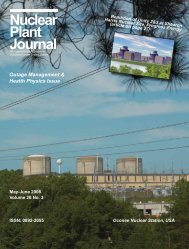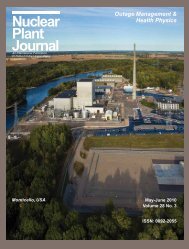Nuclear Plant Journal - Digital Versions
Nuclear Plant Journal - Digital Versions
Nuclear Plant Journal - Digital Versions
- No tags were found...
You also want an ePaper? Increase the reach of your titles
YUMPU automatically turns print PDFs into web optimized ePapers that Google loves.
An Innovative Approach for anOptimized Fuel CycleBy Kevin Walsh, GE Hitachi <strong>Nuclear</strong>Energy.1. Does GE Hitachi <strong>Nuclear</strong> Energy planto discuss the Sodium Cooled PRISM andthe advanced recycling center with theBlue Ribbon Commission?Yes. Our Advanced Recycling Center(ARC) concept couples two major technologies;recycling and a sodium cooledreactor.The first technology is recycling spentlight water fuel. Recycling differs fromreprocessing. Reprocessing uses an aqueousprocess to separate plutonium, whichis then fabricated into mixed oxide (MOX)fuel bundles that can be used in a light waterreactor. Recycling does not separatepure plutonium and uses more of the spentfuel in a sodium fast reactor as further describedbelow.In recycling, a spent fuel bundle is cutinto pieces, put into a molten salt bath formetallurgical separation and separated intothree components.The first component is uranium, whichis about 0.9% enriched in U-235. The uraniumconstitutes about 95% of the bundle.The second component is short-livedfission products, which constitute about4% of the bundle and require approximately500 years in an underground repository(versus 10,000 plus years for current spentfuel).And the third component, which constitutesabout 1% of the fuel, is the actinides(transuranics): Americium, Neptunium,Plutonium and Curium. These arerecovered as a group so that plutonium isnever separated.The natural uranium is combined withthe actinides and fabricated into a metallicfuel. The fuel is then used in a liquidcooled sodium reactor, the PRISM (PowerReactor Innovative Small Modular).The PRISM is the second technology,which will be used to generate power fromAn interview by Newal Agnihotri, Editor,<strong>Nuclear</strong> <strong>Plant</strong> <strong>Journal</strong> at the <strong>Nuclear</strong> EnergyInstitute’s <strong>Nuclear</strong> Energy Assemblyin San Francisco, California in May, 2010.the recycled fuel. With the PRISM reactoras a part of the ARC and at the same location,transportation of the recycled fuel isalso minimized.We’ve already begun discussions withmembers of the Blue Ribbon Commission.Jack Fuller, Chairman of the Board ofGE Hitachi <strong>Nuclear</strong> Energy, has met withseveral members of the commission andis trying to schedule a meeting to presentto the entire commission. We hope to geton the agenda during the most appropriatemeeting of the full commission and alsoits subcommittees to discuss the recyclingconcept. This approach is advantageousbecause it does not separate plutonium, itdoes not generate as much waste as the liquidprocess, it consumes more of the spentfuel and it can be accomplished in regionallocations. The PRISM concepts have beendemonstrated in the Experimental BreederReactor (EBR) and the metallurgical separationsare common processes used todayin metal smelters. We believe we could developa pilot that would accomplish boththe recycling and energy production at thesame location. Once the pilot program isproven, the concept could be rolled outcommercially.2. What do you believe our options are forthe long term waste repository?We support regional recycling centerswhich significantly reduce the requirementsfor a geologic repository.The determination by the Obama administrationto shut down Yucca puts anew onus on the government to determinehow to handle spent fuel. The Blue RibbonKevin WalshKevin Walsh is Senior Vice President ofGlobal <strong>Nuclear</strong> Fuel Cycle Operations forGE Hitachi <strong>Nuclear</strong> Energy. Walsh alsoserves as CEO of Global <strong>Nuclear</strong> Fuel(GNF), a joint venture of GE, Hitachiand Toshiba. Kevin joined GE as a FieldEngineer in 1984. He attended the UnitedStates Merchant Marine Academy wherehe received a B.S. Degree in Marine Engineering.Commission was established to make thisdetermination. There will still be a longtermneed for some type of geological repository,whether it’s the Waste IsolationPilot Project in Carlsbad, N.M.(WIPP) oranother alternative. It is not practical tocompletely close the fuel cycle becauseeven the process of metallurgical separationinvolves fission products that need tobe disposed. While they are a small percentage,less radioactive and have shorterhalf lives than what was planned for Yucca,they will still be present.3. What is the status of ABWRs in operationand in construction worldwide?ABWR has a great operational record.There are four running, four in constructionand more in design and development phases.There will continue to be focus aroundthe world on building ABWRs.We are also in the final stages of certificationwith the <strong>Nuclear</strong> Regulatory Commissionon the ESBWR, which has thelowest core damage frequency of any unitin the world.We’ll continue to actively work in theUS and overseas to try to sell both the ES-BWR and ABWR.4. Is the US ready to sign contracts withIndia for its nuclear reactors under the 123Agreement?The 123 Agreement has been approvedbut there’s still a problem with theconvention for supplemental compensationthat we’re trying to work through rightnow. The latest bill submitted to the Indianparliament contains language that we view38 www.<strong>Nuclear</strong><strong>Plant</strong><strong>Journal</strong>.com <strong>Nuclear</strong> <strong>Plant</strong> <strong>Journal</strong>, July-August 2010


